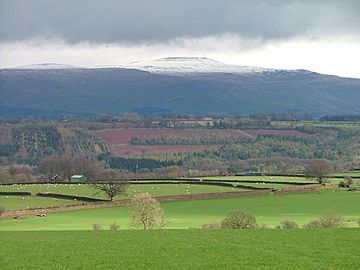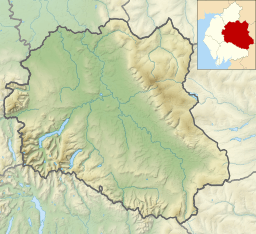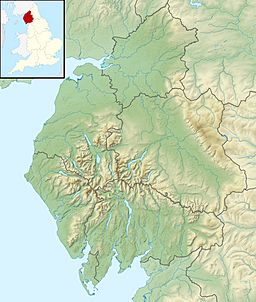Cross Fell facts for kids
Quick facts for kids Cross Fell |
|
|---|---|

Cross Fell seen from the Eden Valley
|
|
| Highest point | |
| Elevation | 893 m (2,930 ft) |
| Prominence | 651 m (2,136 ft) |
| Listing | Hewitt, Marilyn, Nuttall, Hardy |
| Geography | |
| Location | North Pennines, England |
| OS grid | NY687343 |
| Topo map | OS Landranger 91 |
Cross Fell is the highest mountain in the Pennine Hills of Northern England. It is also the highest point in England outside the Lake District. This amazing mountain is found in the North Pennines Area of Outstanding Natural Beauty. This means it's a special place with beautiful landscapes. Cross Fell is located in the county of Cumbria.
The top of Cross Fell is a stony, flat area called a plateau. It stands at 893 metres (2,930 ft) high. This plateau is part of a long ridge, about 12.6 kilometres (7.8 miles) long. This ridge also includes two other fells: Little Dun Fell and Great Dun Fell. These three fells together form a steep slope called an escarpment. This slope rises sharply from the Eden Valley. On the other side, it gently slopes down towards the South Tyne and Tees Valleys.
At the very top of Cross Fell, you'll find a shelter shaped like a cross, built from dry stones. On a clear day, the views from the summit are incredible. You can see across the Eden Valley to the mountains of the Lake District. Looking north from Cross Fell, you can even see across the Solway Firth to the Southern Uplands of Scotland.
Weather and Old Stories
Cross Fell is known for its tough weather. It often has thick fog and very strong winds. A loud, shrieking noise caused by a special wind, called the Helm Wind, is common here. This makes Cross Fell a challenging place to be for much of the year.
Long ago, people called Cross Fell "Fiends Fell." They believed it was a place where evil spirits lived. A famous person named St Augustine of Canterbury is said to have blessed the hill when he visited. After that, it became known as Cross Fell. Some people also think the name "Cross Fell" might mean "angry" fell, because of the strong winds and old stories about spirits.
What is Cross Fell Made Of?

Cross Fell and the fells next to it are mostly made of a hard rock called carboniferous limestone. Where this rock comes to the surface, you can see steep rock faces. There are also layers of shale and gritstone on the fell. On the south and west sides of Cross Fell, the rock faces have been broken up by frost. This creates a slope covered in large, loose rocks called scree. The area also shows signs of being shaped by glaciers long ago. The ground is covered by thin soil and acidic peat.
Cross Fell, Great Dun Fell, and Little Dun Fell form a large area of high ground. All of this land is over 800 metres (2,625 ft) high. This is the biggest block of high land in England. Because it's so high, it keeps its snow cover longer than nearby areas. You can often find snow in the gullies on the north side of Cross Fell as late as May. Sometimes, snow can even last until July, and new snow in June (which is mid-summer) is common!
Nature and Amazing Views
Cross Fell gets a lot of rain and snow, about 2,800 millimetres (110 in) of precipitation each year. The plants that grow here include some rare alpine types. These include the Starry Saxifrage and a mountain Forget-me-not. Cross Fell is covered by a type of grassland called "siliceous alpine and boreal grassland." This kind of plant life is usually found in the highlands of Scotland and Scandinavia. Cross Fell is the most southern place where you can find it. Because of its special plants, Cross Fell is a protected area called a Special Area of Conservation (SAC). Farmers in the area must keep their sheep off the very tops of the fells. This helps protect the natural plants from being damaged.
Cross Fell is easy to spot in the landscape. It stands out against the sky for almost the entire 20 miles (32 km) length of the A66 road between Penrith and Stainmore. You can also see it from many places in the Lake District, like the top of Helvellyn. People can also see it from high ground across Dumfriesshire and Northumberland. It's even said that on very clear days, you might be able to see Cross Fell from the top of Carnedd Llewelyn in Snowdonia (Wales). That's a distance of about 123 miles (198 km) away!



